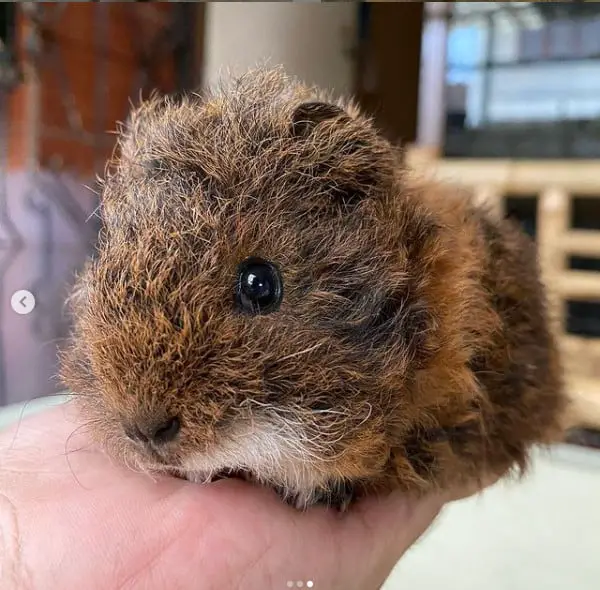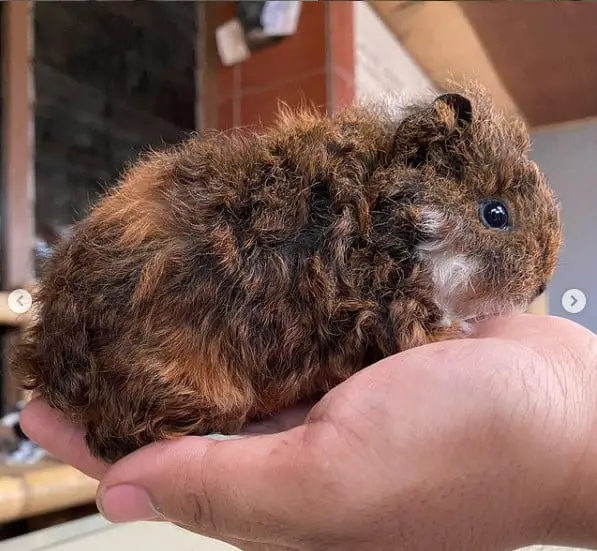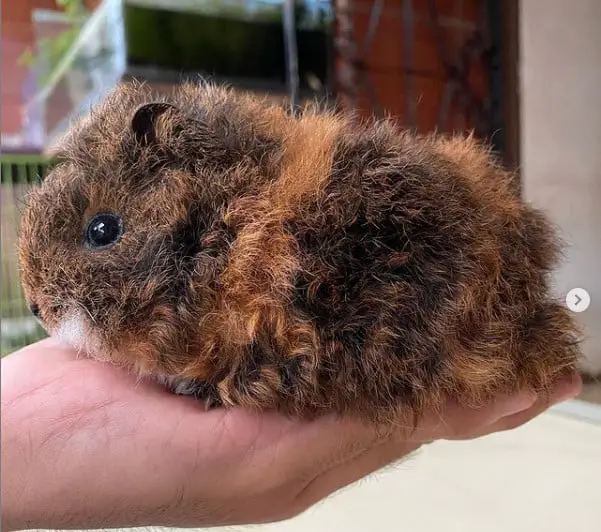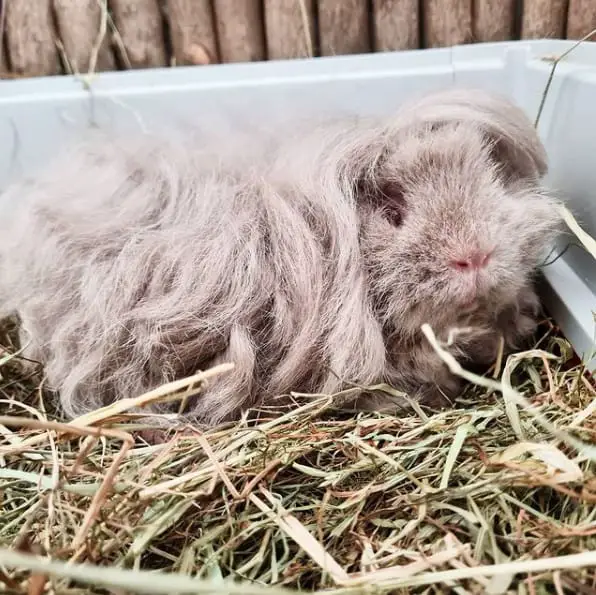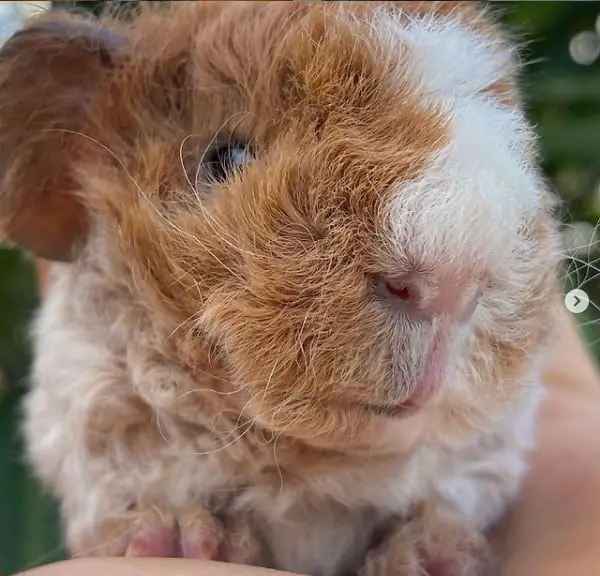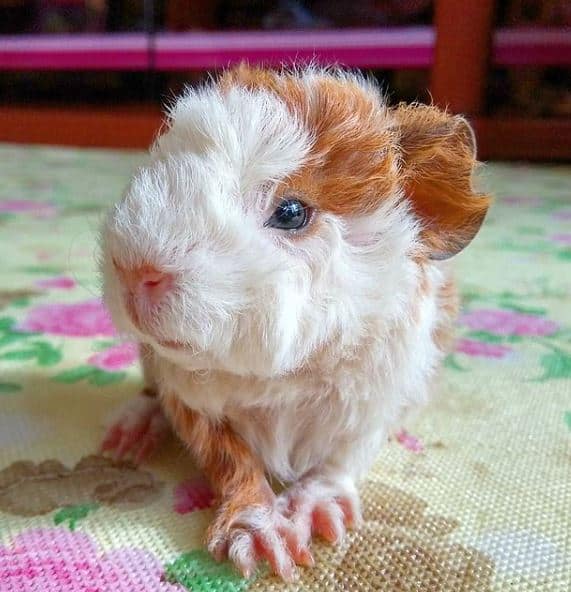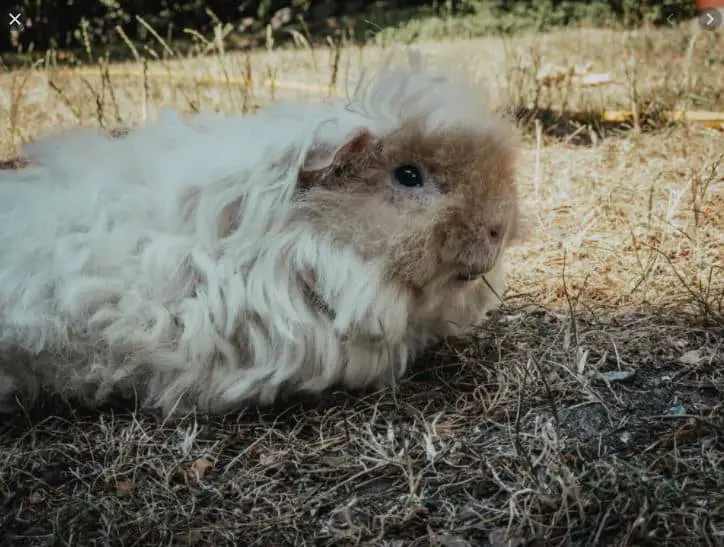Do you want to get a guinea pig as your next pet? I think you’re making a great choice! Guinea pigs are smart, cute, funny, and very loving companions. However, there are many different guinea pig breeds out there, so choosing which one you want can sometimes be a challenge. Therefore, we’re going to take a closer look at one particular guinea pig breed today: the Alpaca Guinea Pig. We’re going to go over this breed’s history, their origins, their temperament, how to care for them, what they look like, and of course, there will be a lot of pictures!
The Alpaca Guinea Pig is a rare, wavy, long-haired guinea pig breed. They resemble the Texel guinea pig quite closely and are often mistaken for them, which makes sense since the Texel is one of their ancestors, the other being the English Peruvian Guinea pig. Most Alpacas have a single rosette on the top of their heads and they often have more rosettes on other parts of their body. They require a special diet to remain healthy, and their long hair needs daily grooming to prevent it from tangling. To learn more about this beautiful breed, keep reading!

History and origins of the Alpaca Guinea Pig
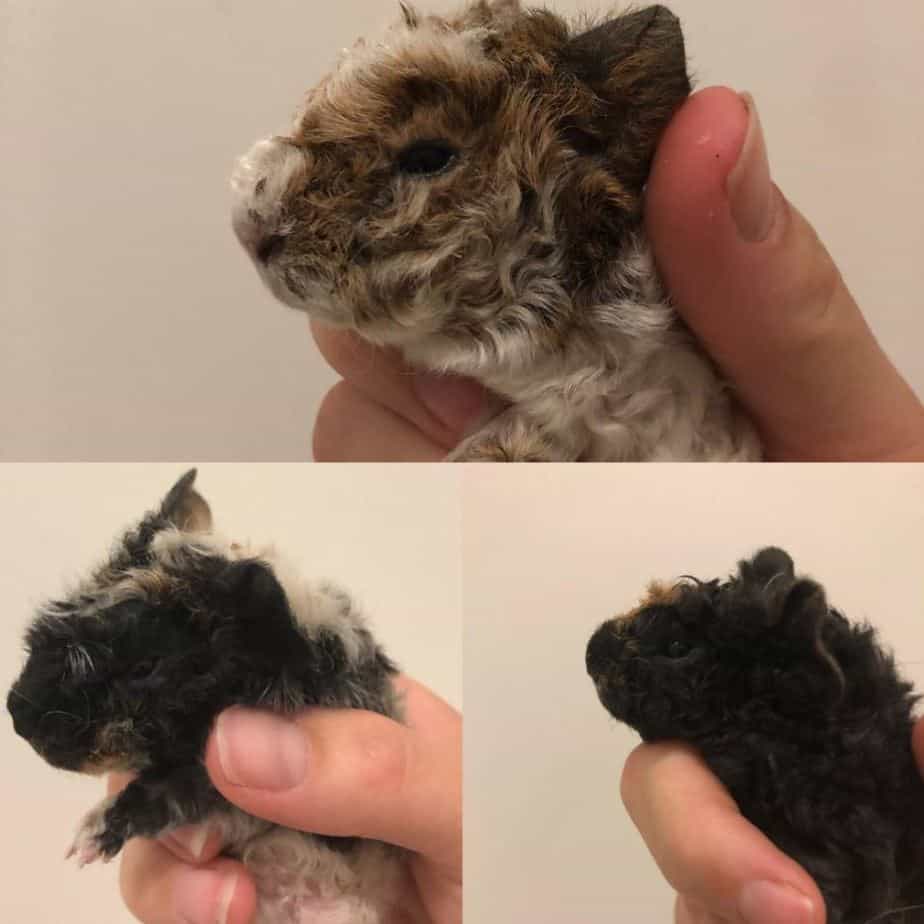
The Alpaca guinea pig got its name from the South American Alpaca Camelid. The Alpaca Camelid also has long, wavy hair like the Alpaca guinea pig, which was how the breed got its name. This breed is well-known for being caring and affectionate to its owners and other cage mates.
The Alpaca guinea pig came into being as a result of crossbreeding between a Texel and an English Peruvian. The breed is not officially recognized by the American Cavy Breeders’ Association but is recognized by other organizations such as the British Cavy Council.
The pigs come in different colors ranging from black, white, brindle, beige, roan, cream, and albino. Some have a single color, while some have a mixture of these colors. The average lifespan of the Alpaca guinea pig is 5 to 8 years.
Appearance Of The Alpaca Guinea Pig
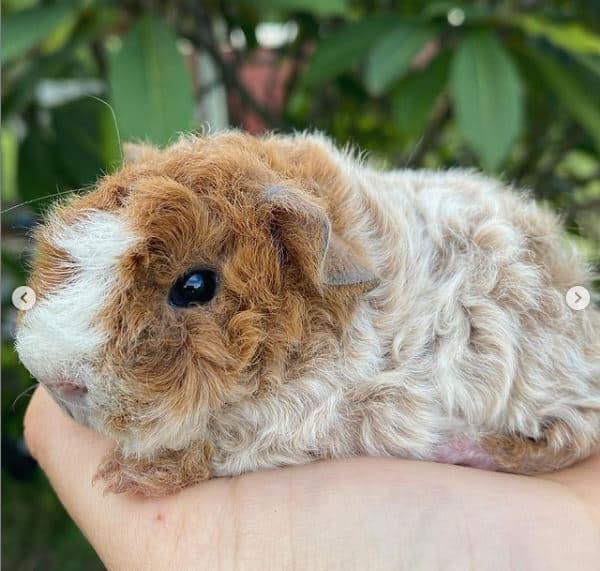
The Alpaca has a look-alike that is often mistaken with: the Texel breed. The most defining feature that sets the Alpaca apart from the Texel is that the Alpaca has bangs if their hair is fully grown out whereas the Texel does not. However, many Alpaca owners choose to trim their guinea pig’s hair, which is why this feature does not always show up in pictures.
The Alpaca guinea pig has a distinctive appearance with its wavy hair and the rosettes on its body, especially on top of the head. Below are some attributes of the Alpaca guinea pig.
Size: 6 to 11 inches
Weight: 600-1100 grams (males heavier/bigger than females)
Lifespan: 5-8 years
Behavior and Temperament of the Alpaca Guinea Pig
The Alpaca guinea pig is often described as being particularly calm and hospitable. Guinea pigs in general are relatively easy-going, but the Alpaca takes it to another level. It’s one of the most affectionate and calm breeds that you can find and it loves cuddling with its human owners or their piggy cage mates.
They have no qualms sharing their cage with other guinea pigs and it’s actually recommended that you keep at least 2 or more guinea pigs together because otherwise, they will get lonely. Guinea pigs originate from the Andes where they roam in large herds. Because of this, they’ve evolved to become very social animals that need a companion when kept as pets.
The Alpaca breed is also remarkably intelligent and can be taught tricks such as spinning in circles, giving high-fives, standing up, jumping over your arm, and they are even able to solve relatively complex mazes.
On the whole, the behavior of the Alpaca breed is ideal for a small pet: intelligent, kind, and easy-going. They’re also great with kids, making them an ideal family pet.
How Much Does The Alpaca Guinea Pig Cost?
The Alpaca guinea pig breed is quite rare and highly sought after. Because of this, demand is high, while supply is low, which makes buying one often expensive. Finding a breeder is not easy, especially in the United States, because they’re not officially recognized by the American Cavy Breeders’ Association.
Since they’re in such high demand and hard to find, they often fetch a high-end price. Expect to pay between $100-$200 if you manage to find one at a breeder. If you’re unable to find one at a breeder your best bet might be to look at a shelter instead.
Care & Grooming
The Alpaca guinea pig requires a lot of care. Any prospective Alpaca owner needs to be sure that they’re able to dedicate time and lots of patience to adequately care for this cavy. It is because of this that this breed is recommended for experienced cavy owners. The long hair on the Alpaca guinea pig requires daily brushing and maintenance to avoid locks, tangles and prevent debris and diseases to its skin. In addition, because of this breed’s long hair, it’s recommended that you give your Alpaca Guinea Pig a bath every month.
Daily care and maintenance of the Alpaca guinea pig are essential to prevent unpleasant smells and help the pig stay happy and healthy.
Food
Timothy hay
Timothy is a grass of the genus of Phleum, and it is native to Asia and Europe. The grass is commercially cultivated as fodder, and Alpaca guinea pigs love it.
Just like other breeds, the Alpaca’s main food intake should consist of Timothy Hay. Timothy hay is crucial for cavies because according to the humane society it helps aid their digestion and prevents their teeth from growing too long. Make sure that they always have access to an unlimited amount of this hay so that they can eat as much of it as they need.
Vegetables
It is also required that you feed your Alpaca guinea pigs vegetables. Around 20% of their total daily food intake by weight should consist of veggies. Keep in mind, this does NOT mean that Alpaca guinea pigs should eat 20% of their body weight in vegetables per day, but rather that 20% of their food’s total weight should consist of vegetables. To make it easier, 20% of their total food intake by weight equates to about a cup of veggies per guinea pig per day.
The bulk of their vegetable intake (around 90%) should consist of leafy green vegetables such as kale, parsley, endive, or romaine lettuce, with smaller amounts of colored vegetables such as carrots and bell peppers.
Vegetables are important for guinea pigs because they provide nutrients that help your piggies stay healthy and happy. The Alpaca guinea pig also requires a quarter cup of pellets daily. This food should not contain any harmful chemicals, and it should be generously fortified with vitamin C.
Tiny Portion Of Fruits
To help with more supply of vitamin C, you can add a tiny slice of quality fruits such as strawberries and blueberries to the diet occasionally. The fruit should be careful added to prevent introducing too much sugar into your cavy’s diet.
Added vitamin C
Just like humans, guinea pigs are incapable of synthesizing their own vitamin C. Because of that, many cavy owners choose to enrich their piggy’s diet with vitamin C supplements.
Water
Guinea pigs should only drink water. Ensure that your Alpaca has access to a water bottle at all times and make sure that you change the water frequently.
Housing your Alpaca Guinea Pig
Guinea pigs may look lazy, but they’re remarkably active animals. In order to stay happy, your cavy needs to have enough space to roam around and get enough exercise. To facilitate this, make sure that their cage is big enough. The Humane Society recommends the following cage sizes:
One guinea pig: 7.5 square feet cage (minimum), but more is better; generally 30″ x 36″ is a good size.
Two guinea pigs: 7.5 square feet (minimum), but 10.5 square feet is preferred; generally 30″ x 50″ is a good size.
Three guinea pigs: 10.5 square feet (minimum), but 13 square feet is preferred; generally 30″ x 62″ is a good size.
Four guinea pigs: 13 square feet (minimum), but more is better; generally 30″ x 76″ is a good size.
Keep in mind that a larger cage is always better. The cage can never really be too big! The one thing you do need to beware of is that no matter how large of a cage you get, you still need to frequently take them outside of their cage. No animal likes being locked up 24/7, so make sure that you take them out so that you can play with them and allow them to explore their surroundings.
Furthermore, it’s recommended that you equip their living space with some toys. Guinea pigs spend up to 20 hours per day awake, and having access to toys helps prevent them from getting bored. Good toys to include in their cage include a tunnel, a swing, a hideout, a playpen, and chew toys.
Training
Alpaca guinea pigs are intelligent and quick learners making them very easy to train. Training your guinea pig is an excellent way to strengthen the bond you have with the animal and will provide them with some of the exercise and mental stimulation that they desperately need. Alpaca guinea pigs are smart little furballs and are easily capable of learning quite a few tricks. Here’s a great video with 25 tricks that you can teach your Alpaca:

Alpaca guinea pig pictures
That was a lot to read! To end this article I’ll leave you with a gallery of beautiful pictures of Alpaca guinea pigs that you can feast your eyes on. I hope this guide was informative and that it helped you make a decision on whether or not this breed is a good fit for you.
You might also be interested in:
- How Long Do American Eskimo Dogs Live? Important Factors and Care Tips - September 29, 2023
- Do American Bulldogs Need Grooming? Essential Tips and Care Guidelines - September 29, 2023
- Do Bengal Cats Enjoy Playing? Essential Tips for Keeping Them Active - September 29, 2023
